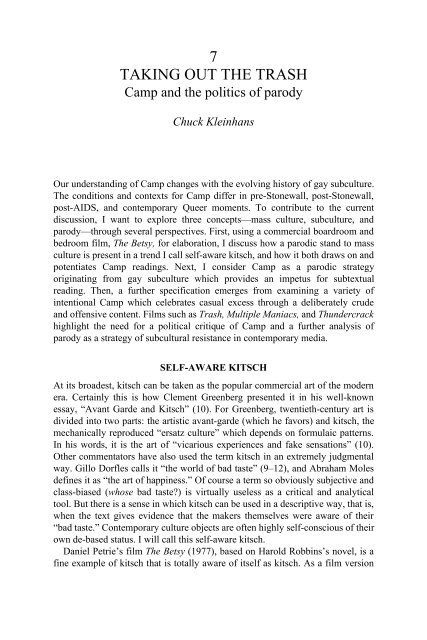Edited by Moe Meyer - Get a Free Blog
Edited by Moe Meyer - Get a Free Blog
Edited by Moe Meyer - Get a Free Blog
Create successful ePaper yourself
Turn your PDF publications into a flip-book with our unique Google optimized e-Paper software.
7<br />
TAKING OUT THE TRASH<br />
Camp and the politics of parody<br />
Chuck Kleinhans<br />
Our understanding of Camp changes with the evolving history of gay subculture.<br />
The conditions and contexts for Camp differ in pre-Stonewall, post-Stonewall,<br />
post-AIDS, and contemporary Queer moments. To contribute to the current<br />
discussion, I want to explore three concepts—mass culture, subculture, and<br />
parody—through several perspectives. First, using a commercial boardroom and<br />
bedroom film, The Betsy, for elaboration, I discuss how a parodic stand to mass<br />
culture is present in a trend I call self-aware kitsch, and how it both draws on and<br />
potentiates Camp readings. Next, I consider Camp as a parodic strategy<br />
originating from gay subculture which provides an impetus for subtextual<br />
reading. Then, a further specification emerges from examining a variety of<br />
intentional Camp which celebrates casual excess through a deliberately crude<br />
and offensive content. Films such as Trash, Multiple Maniacs, and Thundercrack<br />
highlight the need for a political critique of Camp and a further analysis of<br />
parody as a strategy of subcultural resistance in contemporary media.<br />
SELF-AWARE KITSCH<br />
At its broadest, kitsch can be taken as the popular commercial art of the modern<br />
era. Certainly this is how Clement Greenberg presented it in his well-known<br />
essay, “Avant Garde and Kitsch” (10). For Greenberg, twentieth-century art is<br />
divided into two parts: the artistic avant-garde (which he favors) and kitsch, the<br />
mechanically reproduced “ersatz culture” which depends on formulaic patterns.<br />
In his words, it is the art of “vicarious experiences and fake sensations” (10).<br />
Other commentators have also used the term kitsch in an extremely judgmental<br />
way. Gillo Dorfles calls it “the world of bad taste” (9–12), and Abraham Moles<br />
defines it as “the art of happiness.” Of course a term so obviously subjective and<br />
class-biased (whose bad taste?) is virtually useless as a critical and analytical<br />
tool. But there is a sense in which kitsch can be used in a descriptive way, that is,<br />
when the text gives evidence that the makers themselves were aware of their<br />
“bad taste.” Contemporary culture objects are often highly self-conscious of their<br />
own de-based status. I will call this self-aware kitsch.<br />
Daniel Petrie’s film The Betsy (1977), based on Harold Robbins’s novel, is a<br />
fine example of kitsch that is totally aware of itself as kitsch. As a film version


